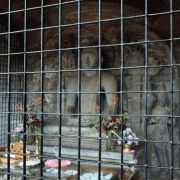Polonnaruwa is an ancient kingdom with a rich history dating back to the 11th century also it can identify as 2nd capital in the history of Sri Lanka. Polonnaruwa is named a UNESCO World Heritage site, which also gives tourists an enthralling look at the nation’s cultural and architectural legacy. Explore the well-preserved ruins, magnificent temples, and fascinating treasures of Polonnaruwa as you set off on a memorable voyage. This city continues to draw tourists from all over the world.

The History of Polonnaruwa
Polonnaruwa became 2nd capital of Sri Lanka after Anuradhapura. From the 11th to the 13th century, it was considered a capital and became a thriving centre of trade, commerce, and culture. The city’s rise to prominence brought forth an era of prosperity and architectural brilliance, leaving behind a legacy that still mesmerizes visitors today.
The rise of the Polonnaruwa Kingdom can be attributed to King Vijayabahu I, who established it as the new capital in 1070 CE. Over the years, subsequent kings expanded the city’s infrastructure, constructed elaborate palaces, and erected impressive temples. However, with the decline of political stability, Polonnaruwa eventually fell into the hands of invaders and was abandoned in the 13th century.
Exploring the Sacred City
The Royal Palace
The Royal Palace, located in the heart of Polonnaruwa, showcases the grandeur and sophistication of ancient Sri Lankan architecture. The remains of this once-majestic structure give visitors a glimpse into the lavish lifestyle of the ruling monarchs. Explore the intricately carved stone pillars, the sprawling gardens, and the impressive audience hall that once witnessed royal ceremonies and gatherings.


The Quadrangle
At the heart of Polonnaruwa lies the Quadrangle, a complex of sacred buildings that exemplify the architectural brilliance of the kingdom. The Quadrangle houses several important structures, including the Vatadage, which is believed to have housed the Relic of the Tooth of the Buddha. Marvel at the intricate stone carvings and the peaceful ambiance that pervades this sacred site.

Gal Vihara
Gal Vihara, a group of magnificent Buddha statues carved into solid granite, is one of the most iconic landmarks in Polonnaruwa. The statues, including the majestic standing Buddha and the reclining Buddha, showcase the exceptional craftsmanship of the ancient Sri Lankan artisans. Take a moment to appreciate the serene beauty and spiritual significance of this revered site.
Rankot Vihara
Rankot Vihara, also known as the Ruwanwelisaya, is a towering stupa that stands as a testament to the religious devotion of the Polonnaruwa Kingdom. With its impressive dimensions and intricate architectural details, Rankot Vihara is a symbol of the city’s religious significance. Climb to the top for a panoramic view of the surrounding landscape and soak in the spiritual atmosphere.
The Magnificent Temples of Polonnaruwa
Lankathilaka Temple
Lankathilaka Temple, dedicated to Lord Buddha, showcases the fusion of South Indian and Sinhalese architectural styles. Its towering brick walls and ornate carvings captivate visitors, while the interior houses a magnificent image house that once enshrined a colossal standing Buddha statue. Explore the temple complex and witness the remarkable blend of artistry and spirituality.

Thuparamaya
Thuparamaya, one of the earliest stupas in Sri Lanka, is a sacred pilgrimage site for Buddhists. This ancient structure features exquisite stone carvings and intricate moonstones, reflecting the craftsmanship of the era. Admire the serene ambiance of the stupa and pay homage to its religious significance.
Kiri Vihara
Kiri Vihara, also known as the Milk Stupa, is a pristine white dagoba that stands in stark contrast to its surroundings. This tranquil structure is believed to house a sacred relic of Lord Buddha. Take a moment to meditate in the peaceful courtyard and appreciate the architectural beauty of Kiri Vihara.
Somawathiya Chaitya
Somawathiya Chaitya, located in 40km away from Polonnaruwa, is a revered Buddhist temple that attracts pilgrims from all over the country and according to the historians believe stupa deposited right tooth rilic of buddha. as well as stupa Surrounded by plain in the evening can observe 100 to 150 group of elephants, this sacred site offers a serene environment for contemplation and spiritual introspection. Discover the tranquility of Somawathiya Chaitya and experience the spiritual essence of Polonnaruwa.
Polonnaruwa’s Hidden Gems
Polonnaruwa Museum
one of the best places to explore in Polonnaruwa. Museum is located next to the Parakrama Samudra dam. Discover an impressive collection of statues, sculptures, and ancient inscriptions, that provide valuable information about the city’s glorious past. it will gain a deep understanding of the kingdom’s architecture, and religious practices in Plonnaruwa era.
Archaeological Park
The Archaeological Park is a vast expanse of ancient structures including raja maligaya and nissanka latha mandapaya that offers a comprehensive overview of Polonnaruwa’s historical significance. best way to explore the site is to rent a bicycle and embark on a self-guided tour through the park Let the mystique of the surroundings transport you back in time.
Parakrama Samudra
Parakrama Samudra, a massive man-made reservoir, is a testament to the engineering marvels of the Polonnaruwa Kingdom. Built by King Parakramabahu I, this reservoir served as a crucial source of irrigation for the region. Enjoy a scenic boat ride on the reservoir and witness the harmonious coexistence of nature and human ingenuity.
Shiva Devale No. 2
Shiva Devalaya No. 2 identify as an ancient Hindu temple dedicated to Lord Shiva. This temple is decorated with magnificent stone carvings, serves as a reminder of the rich cultural diversity that once existed in Polonnaruwa.

The Best Time to Visit Polonnaruwa
you can visit polonnaruwa to all over the year, but better to skip rainy season in december to february. most of the year weather is favorable, with sunny days and minimal rainfall. The dry season allows for comfortable exploration of the archaeological sites without the hindrance of heavy rains.
Getting to Polonnaruwa
Polonnaruwa is easy access city from other major cities in Sri Lanka. easiest way to reach Polonnaruwa is using public transport from Colombo or Kandy. either you can take bus from Colombo or Kandy also you can take train from Colombo. Other than that, you can hire taxi for a more personalized and comfortable journey.

Accommodation Options in Polonnaruwa
Polonnaruwa has range of accommodation options including 5-star hotel to home stay. you can find some place using Airbnb or Booking.com. there are plenty of choices for every traveller. Stay in somewhere near to the ancient city and enjoy the convenience of exploring the ruins at your leisure.
Tips for Exploring Polonnaruwa
Wear comfortable clothing and footwear suitable for walking and exploring archaeological sites. Some of the sites need to have full body covered cloths because of those places are the secret places of Buddhist.
bring enough water and stay hydrated, especially during hot and sunny mid days.
Hire a local guide if possible, for a more enriching experience and in-depth knowledge of the historical significance of the sites.
Practice responsible tourism by not littering and preserving the integrity of the archaeological sites.

FAQs
- Are there guided tours available in Polonnaruwa?
Yes, guided tours are available in Polonnaruwa. You can hire a knowledgeable guide who can provide valuable insights into the historical significance of the sites and enhance your overall experience.
- Can I rent a bicycle to explore Polonnaruwa?
Yes, there are lots of bicycle rentals are available in Polonnaruwa. It’s a popular and best way to explore the ancient city.
- How long does it take to explore the archaeological sites in Polonnaruwa?
The time required to explore the archaeological sites is depends on your level of interest On average, it takes around 3 to 4 hours to visit the main sites, but you can easily spend a full day or one and half day to exploring the city in detail.
- Are there any restrictions for photography within the archaeological sites?
Photography is generally allowed within the archaeological sites in Polonnaruwa. However, some specific areas or temples may have restrictions on photography or require an additional fee for cameras.
- Is Polonnaruwa accessible for travellers with mobility issues? While some areas of the archaeological sites may have uneven terrain, Polonnaruwa is relatively accessible for travelers with mobility issues. It’s recommended to check with the local authorities or tour operators for specific accessibility information and


Leave a Reply